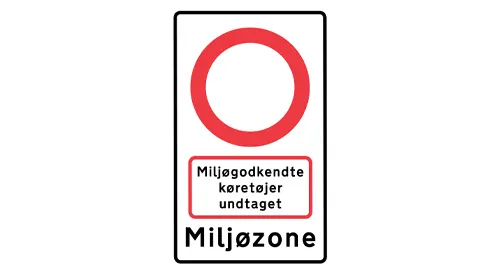- Ready to go
- Low emissions Zones in Denmark
Low emissions Zones in Denmark
Denmark's five largest cities have requirements for diesel-powered passenger cars in the low emissions zones. The requirements apply to both domestic and foreign vehicles.
The Øresund Bridge and the connecting Øresund motorway (E20) are not covered by the rules, however the area around Ørestad - including Fields and Royal Arena - are covered by the new rules as of March 1st, 2025
With this article, Øresundsbro Konsortiet wants to inform our customers about the new rules, but is not involved in Denmark's rules for environmental zones. For questions about the rules and possible fines, we therefore refer to miljoezoner.dk.

Several European countries, Denmark included, has had low emission zones for several years. The aim with these zones is to reduce air pollution, particularly in at risk areas like city centers in major cities.
Since October 1st, 2023, the rules for the low emission zones in Denmark's five largest cities, namely Copenhagen/Frederiksberg, Odense, Aarhus, and Aalborg, are stricter and on March 1, 2025, some areas were expanded.
Fines in Danish low emission zones
Environmental zones are not a foreign concept to the Danish population; since July of 2020 cargo transport, trucks and buses have been subject to the regulations. Just over three years, municipalities revised the regulations to also include passenger cars.
If you are uncertain whether your vehicle meets the requirements, visit Miljøzoner.
Violating the low emission zones triggers an order to pay a fine of 1.500 DKK for passenger cars and vans, and 12.500 DKK for trucks and buses.
There may be exemptions from the rules, see https://miljoezoner.dk/en/
Map of low emission zones in Denmark
The purpose of the low emission zones is to improve air quality and reduce the risk of illness in those who live and travel in the area. Here, you can view detailed maps of the Danish low emission zones.
When you enter a low emission zone in Denmark, you will encounter a sign with a white background, a black border, and a red circle. The Danish word "Miljøzone" is also clearly marked in black letters at the bottom of the sign.

Environmental zones have automatic license plate recognition
Vehicles are scanned through automatic license plate reading. Foreign vehicles are also covered by the automatic license plate reading, as Danish authorities have access to several foreign vehicle registers, including the Swedish one.
Rules for foreign vehicles
Foreign diesel vehicles of older date must be registered online on the day they are used in a low emission zone. You can read more about the rules for registration of foreign vehicles here: Filter registration.

Last Updated: February 27th, 2025